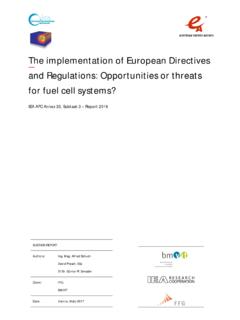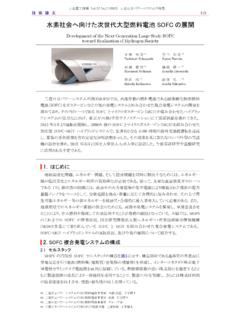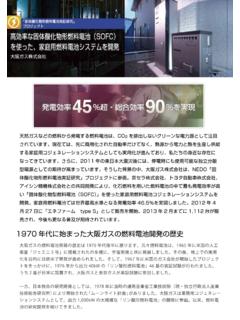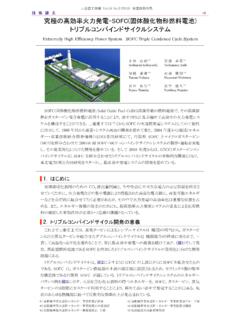Transcription of International Status of SOFC deployment 2017
1 THE YELLOW PAGES OF SOFC TECHNOLOGYI nternational Status of SOFC deployment 2017 Stephen J. McPhail, Jari Kiviaho, Bruno ContiIEAI mplementing Agreement Advanced Fuel CellsAnnex 32 SOFCI talian National Agency for New Technologies,Energy and Sustainable Economic DevelopmentDOSSIERVTT Technical Research Centre of Finland LtdTHE YELLOW PAGES OF SOFC TECHNOLOGYI nternational Status of SOFC deployment 2017 IEAI mplementing AgreementAdvanced Fuel CellsAnnex 32 SOFCTHE YELLOW PAGES OF SOFC TECHNOLOGYI nternational Status of SOFC deployment 2017 IEA - Implementing AgreementAdvanced Fuel CellsAnnex 32 SOFCA uthors: Stephen J. McPhail, Jari Kiviaho & Bruno ContiPublisher: VTT Technical Research Centre of Finland Ltd, Box 1000, 02044 VTT, FinlandISBN 978-951-38-8602-8 (printed); ISBN 978-951-38-8603-5 (online)Printed by Juvenes Print, Helsinki, Finland, 20173 TABLE OF CONTENTSTHE SOFC BASIC PRINCIPLES.
2 4 High efficiency .. 4 Fuel flexibility .. 5 Insignificant emissions .. 5 Silent operation .. 5 How it works .. 6 APPLICATION AREAS .. 7 Mobile, military and strategic .. 7 Auxiliary Power Units (APU) (1 250 kW) .. 8 Stationary small scale combined heat and power (m-CHP) ..10 Stationary medium-large scale ..11A WORLD INDUSTRY: Overview of worldwide SOFC developers ..12 North America ..12 Atrex Energy ..12 Bloom Energy ..15 FuelCell Energy ..16LG Fuel Cell Systems (LGFCS) ..17 Materials and systems Research, Inc. (MSRI) ..18 Protonex ..19 Ultra USSI ..20 Nexceris ..21 Europe ..23 Adelan ..23 Bosch Thermotechnology ..23 Ceres Power ..24 Convion Ltd.. AG ..28 Haldor Tops e AS ..29 Kerafol GmbH ..30 Hexis/Viesmann ..30mPower GmbH ..31 New enerday GmbH ..32 Plansee SE ..33 SOLID power SpA ..34 Sunfire-Staxera ..35 Zegpower ..36 Asia.
3 38 Aisin Seiki ..38 Chaozhou Three-Circle Co., Ltd. (CCTC) ..39G-cell Technology Co., LTD ..40 Gas Authority of India Energy ..41h2e Power Systems Inc..41 Huatsing Jingkun New Energy Technology Co., Ltd ..42 Mitsubishi-Hitachi Heavy Industries (MHI) ..43 MiCo ..45 POSCO Energy Technology Co., Ltd..46 Contact List for SOFC deployment ..474 THE SOFC BASIC PRINCIPLES Solid oxide fuel cells (SOFC) are a cutting-edge technology for converting the chemical energy in hydro-carbon fuels to electrical power and heat by means of an electrochemical reaction. SOFC technology hasmany advantages over conventional power trains, such as combustion engines, including: high efficiency, including at small scale fuel flexibility insignificant NOx, SOx and particulate emissions, reduced CO2 emissions silent and vibration-free efficiency The SOFC differs from conventional technologies such as combustion engines and gas turbines in that itconverts the chemical energy of fuelselectrochemically, generating electrical power directly, avoiding theinefficient steps of combustion and transformation of heat to mechanical work in order to drive the ,%Power installed, MWSteam TurbineDiesel EngineGas 1 10 10080607050403020100 MicroturbineIGCCMCFCSOFCF igure of combustion-based system and fuel cell efficiencies vs.
4 Power installed(ICE= internal combustion engine, GTCC = gas-steam turbine combined cycle, IGCC = integratedgasification combined cycle, PEFC = polymer electrolyte fuel cell, PAFC = phosphoric acidfuel cell, MCFC = molten carbonate fuel cell, SOFC = solid oxide fuel cell, SOFC-GT = SOFCand gas turbine bottoming cycle) [source: ENEA, ]Ideally, the power produced in an SOFC can reach up to 70% of the inlet fuel energy; in practice, within anend-user-ready system, these efficiencies are between 40 60%, depending on the power plant con-figuration. Combustion-based technologies can only reach 55% electrical efficiency in very large-scale powerplants (of hundreds or thousands of Megawatts). The SOFC efficiency is unique in being practicallyindependent of scale, and systems have been demonstrated with 60% net efficiency even at one kilowatt ofdelivered power.
5 5 Fuel flexibility Thanks to the SOFC s high operating temperature (600 900 C), low molecular weight hydrocarbons can beinternally reformed, without the need for an external reformer. With appropriate conditioning, in order toremove harmful contaminants and to ensure a proper balance of the specific carbon com-pounds, suchdiverse fuels can be utilized as natural gas, biogas, ethanol, methanol, propane, LPG (liquefied petroleumgas) and even diesel and jet carbon-free liquid fuels such as ammonia and hydrazine can also be utilized in SOFCs, eventhough the use of the latter remains limited due to its high production cost. Ammonia, used to great extentin industry for the synthesis of fertilizers and explosives, presents the advantages of being low-cost, simpleto store, containing high energy density without production of carbon dioxide.
6 Insignificant emissions By avoiding a combustion process to convert fuel to electricity, the SOFC does not produce nitrous ox-ides(NOx) or fine particulate matter. Furthermore, because sulphur compounds are poisonous for the fuel cell,they need to be extracted from the fuel beforehand to ensure reliable operation, therefore sulphurous oxide(SOx) emissions are insignificant. In this way it is also guaranteed that no harmful compounds are releasedinto the environment, shifting the onus of emission control onto the fuel sup-plier, where it can be handledefficiently and to the SOFC s high efficiency, for a given amount of power produced less primary fuel is required,which means less CO2 is emitted to the atmosphere. If the fuel is obtained from renewable sources, such asbiogas, the operation of the SOFC is effectively carbon-neutral, and of CO2emissions betweencombustion-based systems and a natural gas-fed SOFC [source:Acumentrics, ]Silent operation Electrochemical conversion of the fuel forgoes the need formoving parts for power generation, which means an SOFC system runs essentially vibration- and noise-free: a desirablecharacteristic both in open spaces and closed and vibration emissionsfroma small FC system allow youto hear yourself speak [source:Protonex, ]6 How it works In Figure 4 below, the building block of the SOFC is shown: each of these cells consisting of an anode,electrolyte and cathode can be connected and stacked up to provide any requirement of power.
7 Thismodular build-up is what makes it possible for the SOFC to have practically constant efficiencies fromMegawatt to single watt fuel is fed to the anode side, where the high temperature allows it to be separated into its essentialconstituents. In hydrocarbons, these are hydrogen (H2) and carbon monoxide (CO). H2 and CO react in thesame way at the anode. Taking H2 as an example, it reacts electrochemically to generate two electrons permolecule of hydrogen. This current is made to flow across the electrical load that needs to be powered, andreacts at the cathode side with the air or the oxygen (O2) in particular that is fed there. Every twoelectrons generate an oxygen ion (O2-), which migrates across the gas-tight electrolyte to the anode, whereit reacts with the hydrogen to release again the two electrons that generated the O2- ion, effectively closingthe circuit.
8 In the process, the only by-product formed is water. In the case of CO, the by-product is CO2. Theoutlet of the SOFC therefore produces a clean and relatively pure mixture of water and carbon dioxide. Thus,if necessary, the carbon dioxide can be separated and sequestered much more easily than is the case withthe by-product flows from combustion, where large quantities of nitrogen, contained in the air used forcombustion, dilute the CO2 content and make it energy-and cost-intensive to separate. Furthermore, thepotential to generate clean water could make them attractive for areas and applications where water is inshort the SOFC generates high-efficiency power and heat from fuel and airTo turn the stack of cells to a fully functional power generating system several auxiliary components (the so-called balance-of-plant, BOP) have to be integrated, taking care of fuel pre-treatment, power managementand heat order to preserve the high efficiency of electrochemical conversion in the SOFC, the BOP often needs tobe designed and produced specifically to optimize the integration and minimize parasitic losses.
9 This is animportant part of turning the SOFC to real, viable AREAS Since SOFC systems can be built to any scale between several watts up to several hundreds of kilowatts, theycan serve a large variety of applications, maintaining their properties of fuel flexibility and high electricalefficiency. In particular, the most promising areas for their immediate utilization are: Mobile, military and strategic (<1 kW) Auxiliary Power Units (APU) and back-up power (1 250 kW) Stationary small-scale combined heat and power (m-CHP) (1 5 kW) Stationary medium-large scale ( 10 MW). For each of these fields of applications, there are already pioneering industrial developers attempting toenter the market, gaining valuable experience and expertise in terms of practical know-how and end-userrequirements. This front-line activity is highly necessary in order to make up the lag between the SOFC andthe conventional technologies utilized in these areas, especially in terms of robustness, cost and familiaritywith consumers.
10 That is why for each of the application areas mentioned, a brief overview will be given ofthe current suppliers of end-user-ready , military and strategic One of today s major concerns in the energy field is to fulfil the harsh requirements for mobile applications(<1 kW), especially in the field of military defence and strategic reconnaissance. Above all reduced weightand volume with high power densities, as well as robustness, are the requested iRobot PackBot UGV AM is a reconnaissance unmanned system,capable of12 hours autonomy covering about 40 miles of terrain. This System ishybridized with a standard battery for hours (8 miles) extra autonomy[source: Ultra-AMI, Proceeding of Fuel Cell Seminar and Exposition 2011]The portable electronics market represents a niche market for solid oxide fuel cell micro-systems. State ofthe art Li-ion and Ni-ion rechargeable batteries and the PEMFC have significantly lower energy densities thanthe SOFC.








